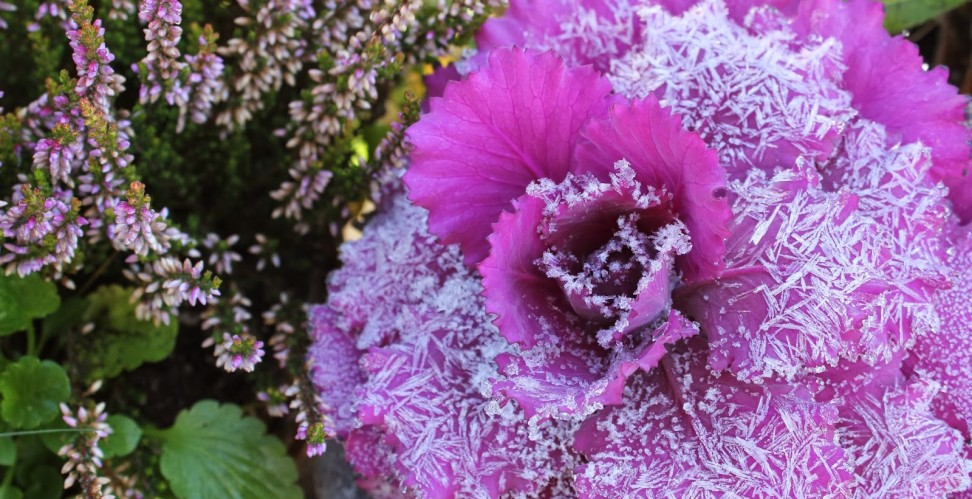 Ornamental cabbage is an extraordinary representative of the Cruciferous family. Refers to a separate sheet view. While the summers bloom in autumn, the main decoration of the garden is ornamental cabbage, the lacy leaves of which acquire saturated shades of purple, cream and red. After the first frost, the leaves become edible: they are very tasty and healthy. They contain up to 20% solids. Cabbage is also rich in proteins, fiber, minerals and amino acids.
Ornamental cabbage is an extraordinary representative of the Cruciferous family. Refers to a separate sheet view. While the summers bloom in autumn, the main decoration of the garden is ornamental cabbage, the lacy leaves of which acquire saturated shades of purple, cream and red. After the first frost, the leaves become edible: they are very tasty and healthy. They contain up to 20% solids. Cabbage is also rich in proteins, fiber, minerals and amino acids.
Content
general description
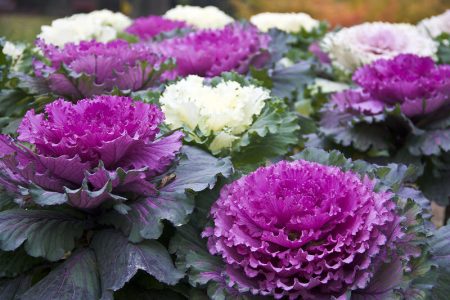 The Latin name for ornamental cabbage is Brassica oleracea var.acephala. This is a subspecies of garden cabbage. It is also called curly cabbage or brassica. It was imported to Russia at the end of the 19th century from Japan. It was in this country that breeders noticed a promising culture in terms of breeding. They began to interbreed parent species to breed hardy, decorative varieties. Cabbage can be called a universal plant. Her can be grown as a food crop or used as garden decoration.
The Latin name for ornamental cabbage is Brassica oleracea var.acephala. This is a subspecies of garden cabbage. It is also called curly cabbage or brassica. It was imported to Russia at the end of the 19th century from Japan. It was in this country that breeders noticed a promising culture in terms of breeding. They began to interbreed parent species to breed hardy, decorative varieties. Cabbage can be called a universal plant. Her can be grown as a food crop or used as garden decoration.
Ornamental cabbage is a two-year-old herbaceous plant. In the first year, a rosette of leaves forms, and in the second - flower-bearing organs and seeds. The stem height, depending on the variety, can be from 20 to 130 centimeters. The size of the leaves also varies: up to 60 centimeters in length and up to 30 in width. The structure of the sheet plate can be smooth, wavy, dissected, serrated and corrugated. The leaves of some varieties are narrowed and very elongated, while others are rosette-shaped. Their color is vibrant and diverse. In addition to all shades of green foliage, it is painted in pink, purple, yellow and white.
Leaves do not form into a dense stump, as in white cabbageand form a large, loose basal rosette similar to a flower. The central leaves are sessile, and the outer ones have petioles. The growing season of brassica lasts from early July to late October (150 days). Decorativeity begins to appear with the advent of cold weather. Ornamental cabbage is a cold-resistant plant. In moderate winters, it can remain in the open ground, and with the advent of spring will continue its growth.
Young leaves are edible. They are very nutritious, saturated with vitamin C and carotene. They make all kinds of salads and side dishes. Cabbage does not lose its taste and nutritional value even after heat treatment.
Varieties and hybrids of decorative cabbage
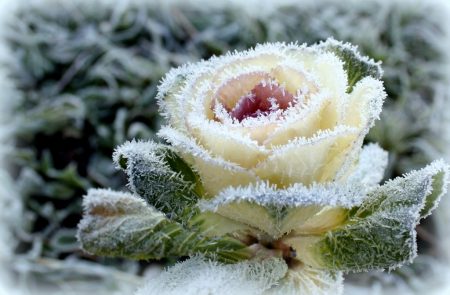 The interest of gardeners in this unique vegetable has led to the emergence of many varieties and hybrids, different among themselves by the growth of plants, the structure and shape of the leaves and their colors. There are tall varieties in which the bushes grow 130-150 centimeters. In contrast, there are dwarf varieties, the height of which barely reaches 30 centimeters. Some hybrids have a cup-shaped form of inflorescence, others are elongated upwards with long serrated spears.In cup-shaped forms, as a rule, the outer leaves are painted light green, while the core can be creamy. purple pink or scarlet color. Interestingly, as the temperature decreases, the color of the foliage becomes brighter, more saturated. All varieties and hybrids of brassica are combined in two groups: annual and biennial plants. And they are all quite simple to grow and unpretentious to the growing conditions.
The interest of gardeners in this unique vegetable has led to the emergence of many varieties and hybrids, different among themselves by the growth of plants, the structure and shape of the leaves and their colors. There are tall varieties in which the bushes grow 130-150 centimeters. In contrast, there are dwarf varieties, the height of which barely reaches 30 centimeters. Some hybrids have a cup-shaped form of inflorescence, others are elongated upwards with long serrated spears.In cup-shaped forms, as a rule, the outer leaves are painted light green, while the core can be creamy. purple pink or scarlet color. Interestingly, as the temperature decreases, the color of the foliage becomes brighter, more saturated. All varieties and hybrids of brassica are combined in two groups: annual and biennial plants. And they are all quite simple to grow and unpretentious to the growing conditions.
One of the most popular varieties is the hybrid "Vyacheslavna" (another name is "Voronezh White"). The plant is stunted (can grow up to 50 centimeters), forms a sprawling lush rosette of blue, yellow and white tones.
Another variety, “Burgundy Lace,” is known for its emerald-colored lace foliage. Grown as an annual culture.
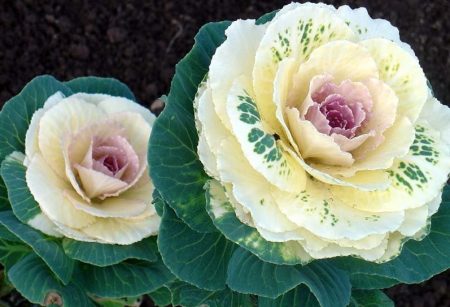 Interesting in the structure of the bush cabbage "Sunrise F1". Her leaf rosette of delicate cream color is very similar in structure to the inflorescence of a rose.
Interesting in the structure of the bush cabbage "Sunrise F1". Her leaf rosette of delicate cream color is very similar in structure to the inflorescence of a rose.
A striking representative of decorative cabbage is the hybrid “Crane Bicolor F1”. The peculiarity of the species in the structure of the plant: small rosettes are formed on long stems. The leaves are smooth and shiny, they are tightly pressed against each other. In the fall, they begin to blossom like a rose, overflowing with yellow-red, burgundy-pink hues.
The most popular series of kale is the Kale series. Tall, palm-like stems with corrugated leaves of different colors look elegant in tall flowerpots.
The true beauty is represented by the hybrid Nagoya Belaya F1 variety. This is a unique plant with fringe leaves. The outer layer of the leaves is green, but the central plates are painted in cream or pure white. The most unpretentious varieties include "Colors of the East" with a pink overflow of leaves and "Osaka", the foliage of which is painted immediately in three bright colors.
Features of growing brassica
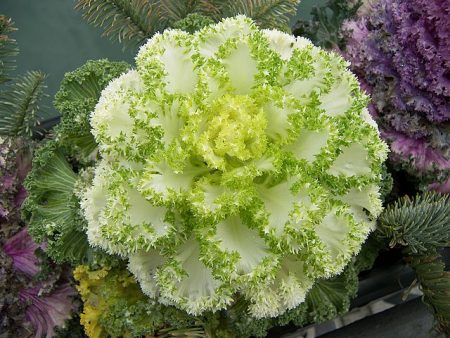 If you are already familiar with agricultural cultivation white cabbage, then you will not have any problems when cultivating decorative cabbage, because the principles of cultivation of these types of cabbage are very similar. Cabbage is an undemanding crop. It can show itself quite well, growing in the shade, on alkaline soils. However, for full development, it is better to plant it in well-lit areas, in light loam, with a high occurrence of groundwater.
If you are already familiar with agricultural cultivation white cabbage, then you will not have any problems when cultivating decorative cabbage, because the principles of cultivation of these types of cabbage are very similar. Cabbage is an undemanding crop. It can show itself quite well, growing in the shade, on alkaline soils. However, for full development, it is better to plant it in well-lit areas, in light loam, with a high occurrence of groundwater.
Landing time
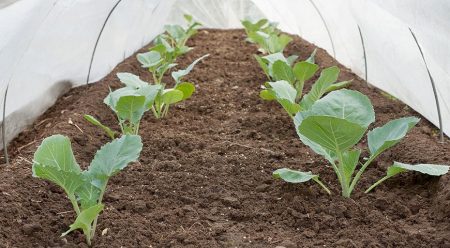 Brassica is grown in seedlings. If you want to get a lush bush early, then sowing is carried out at home in mid-March. At the time of transplantation into the soil, the age of the seedlings must be at least 80 days. That is, planting in the flower garden is carried out no earlier than the end of May. If you plant cabbage later, the seedlings will not take root well and grow in the future.
Brassica is grown in seedlings. If you want to get a lush bush early, then sowing is carried out at home in mid-March. At the time of transplantation into the soil, the age of the seedlings must be at least 80 days. That is, planting in the flower garden is carried out no earlier than the end of May. If you plant cabbage later, the seedlings will not take root well and grow in the future.
Otherwise, sowing can be carried out from mid-April to early May in a film greenhouse or under temporary shelter. It is important that at the time of sowing the land has already been warmed up (up to 8 degrees Celsius) and have sufficient reserves of snow moisture.
Soil requirements
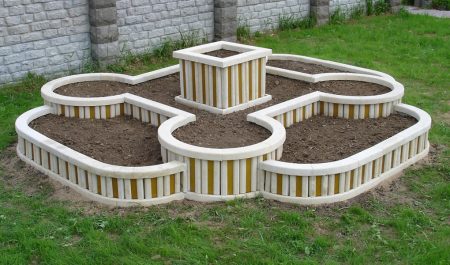 It should be borne in mind that seedlings germinate well in fertile, loose and light soil. Therefore, the soil mixture consists of several components that will provide the seeds with everything necessary for rapid germination. In equal proportions mix sod, peat, humus and river sand. Then a glass of ash is added to the bucket of the finished soil substrate. Before sowing, the soil is calcined in the oven or disinfected with a manganese solution.At the time of planting the cabbage, the soil should be slightly moistened - this will allow the seeds to more quickly “mate” with the ground.
It should be borne in mind that seedlings germinate well in fertile, loose and light soil. Therefore, the soil mixture consists of several components that will provide the seeds with everything necessary for rapid germination. In equal proportions mix sod, peat, humus and river sand. Then a glass of ash is added to the bucket of the finished soil substrate. Before sowing, the soil is calcined in the oven or disinfected with a manganese solution.At the time of planting the cabbage, the soil should be slightly moistened - this will allow the seeds to more quickly “mate” with the ground.
Capacity selection
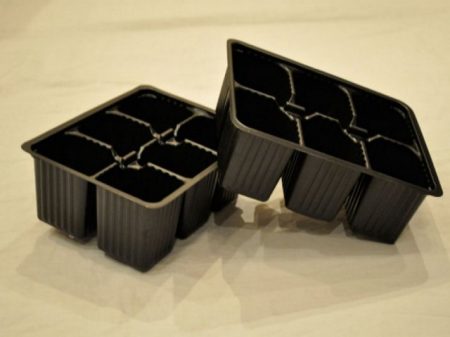 Sowing seeds is carried out in seedlings. It can be wooden or plastic boxes of small depth, but quite wide. Due to the fact that cabbage does not tolerate picking, it is preferable to sow seeds in separate peat cups or immediately sow them in open ground at a remote distance from each other. It is important to provide the nursery with a drainage hole to avoid stagnation of water and soil compaction.
Sowing seeds is carried out in seedlings. It can be wooden or plastic boxes of small depth, but quite wide. Due to the fact that cabbage does not tolerate picking, it is preferable to sow seeds in separate peat cups or immediately sow them in open ground at a remote distance from each other. It is important to provide the nursery with a drainage hole to avoid stagnation of water and soil compaction.
Sowing seeds
 The seeds of brassica are very small and it is difficult to sow locally, therefore they are poured in heaps, trying to place no more than three seeds on one plot. Sowing is carried out in narrow grooves buried by 1.5 centimeters. If planting is carried out in separate containers, then 2-3 seeds are put in one hole. Then, when the shoots rise, only the strongest of them will be left. In the stage of two leaves make a pick. It is usually very difficult to transplant seedlings without damaging the root system, so it is recommended to transfer seedlings to a new place of growth along with a lump of earth on the roots.
The seeds of brassica are very small and it is difficult to sow locally, therefore they are poured in heaps, trying to place no more than three seeds on one plot. Sowing is carried out in narrow grooves buried by 1.5 centimeters. If planting is carried out in separate containers, then 2-3 seeds are put in one hole. Then, when the shoots rise, only the strongest of them will be left. In the stage of two leaves make a pick. It is usually very difficult to transplant seedlings without damaging the root system, so it is recommended to transfer seedlings to a new place of growth along with a lump of earth on the roots.
Temperature
 At a temperature of +18 degrees, the first shoots appear by the fourth day. As soon as all the seedlings hatch, the temperature is reduced to +10 in the afternoon and + 6-night. Such a measure is necessary for the harmonious germination of sprouts without excessive stretching. After a couple of weeks, the degree is slightly increased: now the seedlings should develop at a temperature of + 13-16 degrees during the day and + 8-10 degrees at night. Ornamental cabbage is a long day culture. That is, for development, it must receive sunlight for at least 14 hours a day. Therefore, on cloudy days, seedlings are artificially illuminated.
At a temperature of +18 degrees, the first shoots appear by the fourth day. As soon as all the seedlings hatch, the temperature is reduced to +10 in the afternoon and + 6-night. Such a measure is necessary for the harmonious germination of sprouts without excessive stretching. After a couple of weeks, the degree is slightly increased: now the seedlings should develop at a temperature of + 13-16 degrees during the day and + 8-10 degrees at night. Ornamental cabbage is a long day culture. That is, for development, it must receive sunlight for at least 14 hours a day. Therefore, on cloudy days, seedlings are artificially illuminated.
Seedling Care
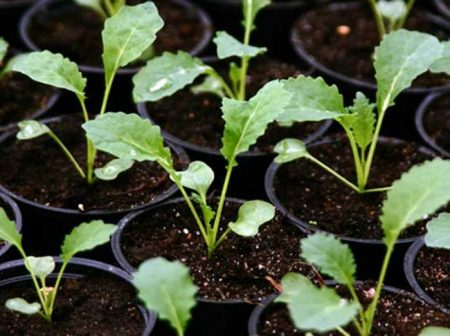 For full growth, seedlings should always be in semi-moist soil. Watering the seedlings very carefully, trying not to wash the soil off the roots. At the first stages, it is enough to spray the seedlings with spray water. As soon as the sprouts grow a little, thinning is carried out. And when two leaves appear on the bushes, they dive. A week after the picking, cabbage is fed for the first time. This time, complex mineral compositions are introduced into the soil. After another two weeks, the seedlings are fed a second time.
For full growth, seedlings should always be in semi-moist soil. Watering the seedlings very carefully, trying not to wash the soil off the roots. At the first stages, it is enough to spray the seedlings with spray water. As soon as the sprouts grow a little, thinning is carried out. And when two leaves appear on the bushes, they dive. A week after the picking, cabbage is fed for the first time. This time, complex mineral compositions are introduced into the soil. After another two weeks, the seedlings are fed a second time.
Planting grown seedlings is carried out in late April or in early May. It can first be planted for growing in a quiet corner of the garden, and in the middle of summer planted in a flower garden. Separate holes are made for seedlings, staggered. The distance between them should be at least 30 centimeters. Plants are buried in the soil to the first leaves. From above the earth is well compacted and watered.
Site selection
Brassica prefers sunny, quiet areas, although it grows tolerably well in light partial shade. Cabbage, like her sisters, demanding soil fertility. The soil should be light, loose, well moistened. Close up the cabbage bed, a generous portion of humus or compost, mineral fertilizers, ash are introduced into the soil. Too acidic soil is deoxidized in the fall with lime.
Planting cabbage in the ground
Shallow holes are prepared for seedlings at a distance of 30 centimeters from each other. At the bottom of the holes lay a handful of humus and ash, mineral fertilizer (nitroammofosku, nitrofosku or fertilizer Rost-1). Seedlings are planted before the growth of the lower leaves. Top trample the earth and watered. You can sprinkle seedlings with earth or ash. And it is better to cover with plastic or plastic bottles - this will protect the fragile bushes from insects, rains and the scorching sun.
Cultivation of cabbage in the soil
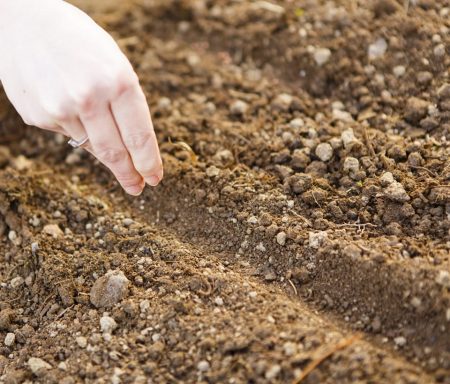 Such a cold-resistant plant can be grown immediately in the garden, bypassing the seedling period. However, this method has disadvantages. Firstly, in regions with short and wet summers, plants grown by the soil method do not have time to fully develop to optimal sizes. Secondly, young immature plants are often subjected to sabotage of a sacral flea or aphid, and they often become ill with a black leg. Sow seeds in the ground around mid-April, when the land will be ready to receive a "guest".
Such a cold-resistant plant can be grown immediately in the garden, bypassing the seedling period. However, this method has disadvantages. Firstly, in regions with short and wet summers, plants grown by the soil method do not have time to fully develop to optimal sizes. Secondly, young immature plants are often subjected to sabotage of a sacral flea or aphid, and they often become ill with a black leg. Sow seeds in the ground around mid-April, when the land will be ready to receive a "guest".
In order for the seeds to sprout as soon as possible, an improvised greenhouse is arranged over the plantings. It will protect against sudden cold weather. On warm days, the film is removed. It is important that during the growth of seedlings, they receive the optimal amount of light, heat and moisture. Cabbage will not grow in cold land. Already in mid-May, grown bushes can be transplanted to a flower bed. At the beginning of the active growth of leaves, cabbage is fed with a mullein solution. Then, the concentration of nitrogen is reduced in priority mineral supplements.
Outdoor cabbage care
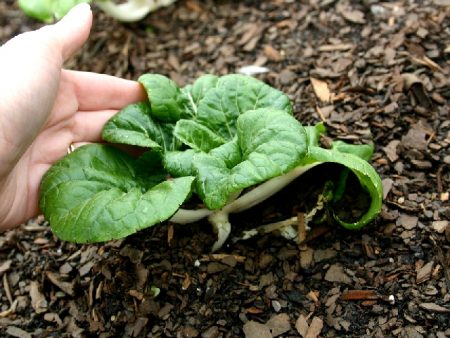 Brassica, as befits a cabbage, is very fond of water. Watering should be done every other day, pouring 500 milliliters of water on young plants, and up to 2 liters on adults. In rainy periods, watering is stopped, and in dry periods it is watered daily. In the same time cabbage does not tolerate excessive moisture. Illiterate watering can lead to stagnation of moisture at the base of the bush, soil compaction. All this affects the development of the cabbage bush: the roots cease to receive enough oxygen and can begin to rot. The plant can be affected by various fungal diseases, in particular the black leg, gray rot.
Brassica, as befits a cabbage, is very fond of water. Watering should be done every other day, pouring 500 milliliters of water on young plants, and up to 2 liters on adults. In rainy periods, watering is stopped, and in dry periods it is watered daily. In the same time cabbage does not tolerate excessive moisture. Illiterate watering can lead to stagnation of moisture at the base of the bush, soil compaction. All this affects the development of the cabbage bush: the roots cease to receive enough oxygen and can begin to rot. The plant can be affected by various fungal diseases, in particular the black leg, gray rot.
Cabbage leaves also need moisture during growth and flowering. Therefore, they need to be "pampered" by watering from a watering can by sprinkling.
Mulching the area with straw, sawdust and mowed grass will help reduce the amount of watering and restrain weed growth. A 5-centimeter layer of mulch will protect the roots from overheating. In addition, by overheating, the covering layer will become an additional source of nutrients for the roots. Mulch under cabbage will also save you from loosening the earth after each watering.
Top dressing
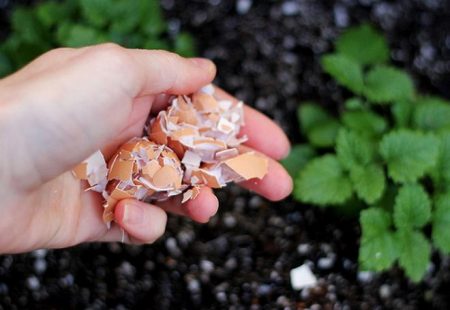 Brassica good responds to top dressing, which during the growing season can be from two to five. The plant prefers to "feast on" mineral fertilizers. Organics are necessary for her only at the initial stage, during the growth of leaves. Brassica grows well after top dressing with mullein, which is especially useful to the plant in June, during the formation of leaves. Then superphosphate and potassium are introduced into the soil, necessary so that the plain green leaves gradually begin to change their color to multi-colored.
Brassica good responds to top dressing, which during the growing season can be from two to five. The plant prefers to "feast on" mineral fertilizers. Organics are necessary for her only at the initial stage, during the growth of leaves. Brassica grows well after top dressing with mullein, which is especially useful to the plant in June, during the formation of leaves. Then superphosphate and potassium are introduced into the soil, necessary so that the plain green leaves gradually begin to change their color to multi-colored.
Diseases and Pests
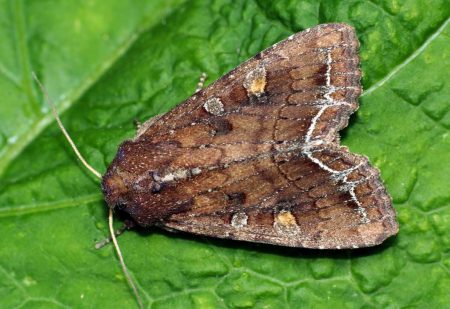 Most often, ornamental cabbage is affected by fungal diseases such as late blight, powdery mildew and root rot. If the symptoms of the disease have just appeared, then you can stop the development of the fungus by adjusting the growing conditions of the culture. With severe damage to cabbage bushes, they are treated with fungicides such as Quadris, Fundazole. If the disease has spread throughout the plant, then it is better to remove it from the general plantation until it has infected healthy bushes.
Most often, ornamental cabbage is affected by fungal diseases such as late blight, powdery mildew and root rot. If the symptoms of the disease have just appeared, then you can stop the development of the fungus by adjusting the growing conditions of the culture. With severe damage to cabbage bushes, they are treated with fungicides such as Quadris, Fundazole. If the disease has spread throughout the plant, then it is better to remove it from the general plantation until it has infected healthy bushes.
Often on brassica you can see butterflies-cabbage and scoop, who prefer to lay eggs in the thick of dense numerous leaves. Do not mind eating lush aphid foliage, cabbage flea, slugs, ticks - crucifer lovers.Most often, gardeners use folk remedies to rid plants of pests: they wash off livestock with soapy water, treat them with ash and various odorous tinctures (from garlic, wormwood, and onion husks). If the pest population is growing, it is worth starting treatment with insecticides. In this case, Aktara, Bikol, DetisProfi help well.
Growing Your Seeds
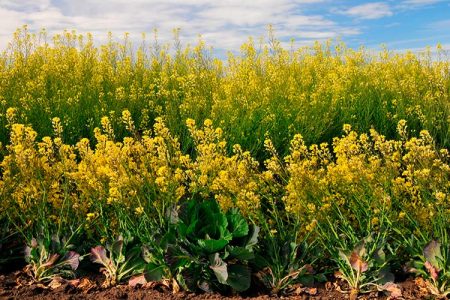 If there is a desire to get seeds from cabbage, then for the winter the plant is left in the garden (if the winter is not frosty) or transplanted into a pot and kept in the cellar or basement in the winter. The next year, cabbage is again planted in the garden. In summer, the plant starts up peduncles, which begin to bloom in late June. After in their place pods are formed, stuffed with seeds. They finally ripen in the fall. Appearance will tell about their readiness: the pods will dry out, wrinkle, become light brown. Then they are cut off, tied in bundles and suspended in a dry place so that they "ripen". When they are completely dry, they will begin to crack, and the seeds themselves will crumble.
If there is a desire to get seeds from cabbage, then for the winter the plant is left in the garden (if the winter is not frosty) or transplanted into a pot and kept in the cellar or basement in the winter. The next year, cabbage is again planted in the garden. In summer, the plant starts up peduncles, which begin to bloom in late June. After in their place pods are formed, stuffed with seeds. They finally ripen in the fall. Appearance will tell about their readiness: the pods will dry out, wrinkle, become light brown. Then they are cut off, tied in bundles and suspended in a dry place so that they "ripen". When they are completely dry, they will begin to crack, and the seeds themselves will crumble.
Harvesting
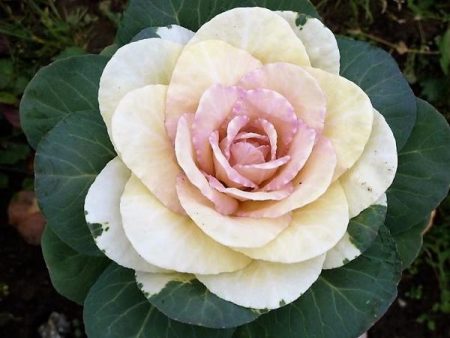 From mid-August, you can begin to remove young leaflets for salads. It is not necessary to cut off all the leaves at once. You can cut 2-3 leaves, and in their place new juicy shoots will soon grow. With the onset of stable frosts, edible cabbage can be transplanted into a container and grown at home. Cut leaves of cabbage are stored for a short time - up to 5 days.
From mid-August, you can begin to remove young leaflets for salads. It is not necessary to cut off all the leaves at once. You can cut 2-3 leaves, and in their place new juicy shoots will soon grow. With the onset of stable frosts, edible cabbage can be transplanted into a container and grown at home. Cut leaves of cabbage are stored for a short time - up to 5 days.
Use in landscape design
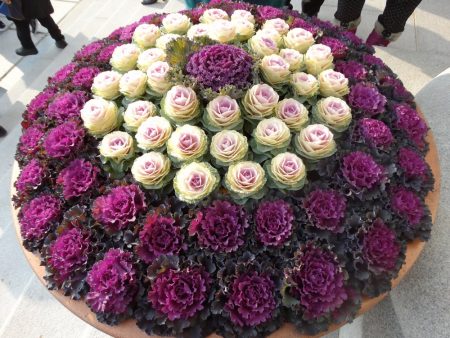 This full-leaved plant goes well with various flowering shrubs. Growing among other flowers, cabbage bushes outwardly resemble huge roses of various shades of red and burgundy. Most often, it is located in the back tier next to undersized "light" flowering plants. Cabbage also looks good in a separate location: when tapeworm planting is usually used several varieties, different in color. If you want to fill a large area on the site with bright colors, then for economic purposes you can safely choose decorative cabbage: thanks to its lush volumetric habit, 5-6 seedlings will be enough (the diameter of the outlet can reach 50-60 centimeters).
This full-leaved plant goes well with various flowering shrubs. Growing among other flowers, cabbage bushes outwardly resemble huge roses of various shades of red and burgundy. Most often, it is located in the back tier next to undersized "light" flowering plants. Cabbage also looks good in a separate location: when tapeworm planting is usually used several varieties, different in color. If you want to fill a large area on the site with bright colors, then for economic purposes you can safely choose decorative cabbage: thanks to its lush volumetric habit, 5-6 seedlings will be enough (the diameter of the outlet can reach 50-60 centimeters).
It can be placed along garden paths or in rock gardens. Determinant varieties look unusual in pots and hanging flower pots. With the help of cabbage, you can create a beautiful container composition.
Ornamental Cabbage Growing Tips
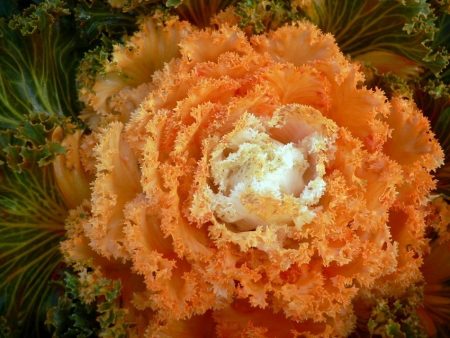 Even a novice gardener can grow a cabbage flowerbed on his plot. Agricultural technology in the case of this culture is quite simple to implement. However, if you want to get an unprecedented riot of colors in the first year of growing cabbage, you can use the following tips from gardeners who already successfully cultivate this vegetable in their areas:
Even a novice gardener can grow a cabbage flowerbed on his plot. Agricultural technology in the case of this culture is quite simple to implement. However, if you want to get an unprecedented riot of colors in the first year of growing cabbage, you can use the following tips from gardeners who already successfully cultivate this vegetable in their areas:
- If the cabbage grows too high, then its stem can be pinched. Then in place of one large "flower" will appear many small of the side branches.
- Brassica is often damaged by various insects. Regular treatment with tobacco dust will help protect cabbage from pests. To prepare a useful infusion, tobacco or shag is mixed with water, insisted for several days. Then the concentrate is filtered, a little soap is added (for adhesion) and the bushes are sprayed every 14 days. The odorous solution will scare away animals.
- Excessive application of nitrogen fertilizers dramatically reduces the plant's immunity to fungal diseases. In the cultivation of cabbage, it is better to give preference to complex mineral dressings, including potassium chloride, superphosphate and ammonium nitrate. Such compositions, on the contrary, will give plants vitality.
- At home, to grow a full-fledged brassica does not work due to the fact that the plant develops at a temperature of + 5-8 degrees.In warm and dry air, seedlings will not develop.
- When planting decorative cabbage in the ground, it should be borne in mind that plants are demanding for a large space. If you plant them densely, then the bushes will greatly stretch, and a magnificent rosette will not form.
Ornamental cabbage can not only become the main decoration of the garden, but also the family table. Using brassica, you can contemplate the beauty of lush variegated rosettes until late autumn. And if it is transplanted into volumetric pots - then before the New Year.

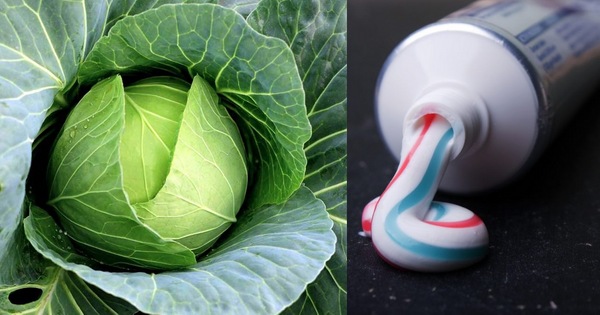
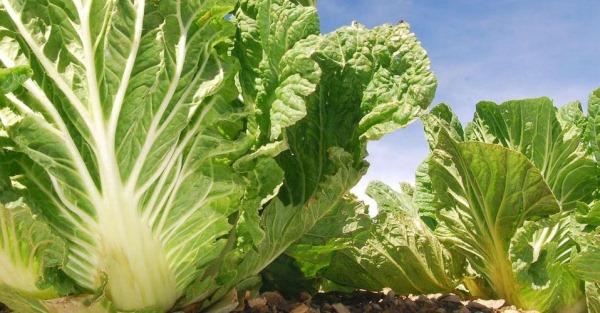
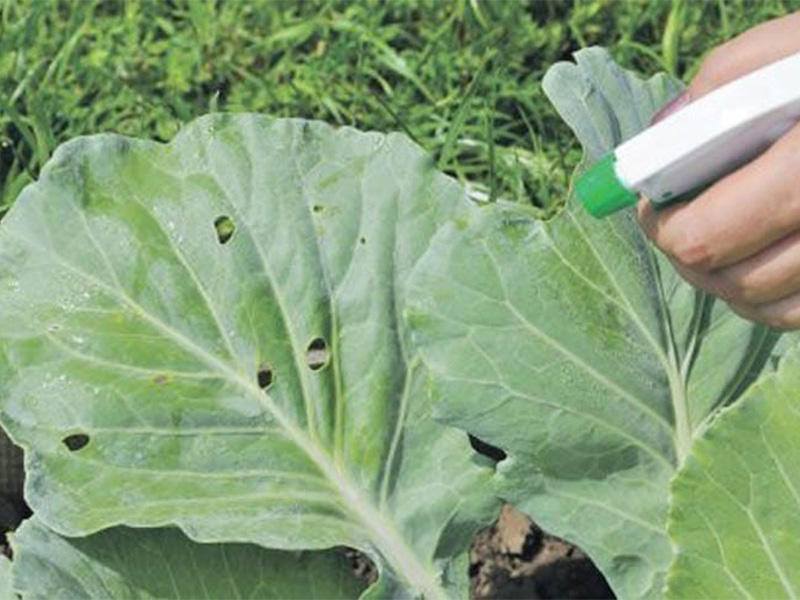
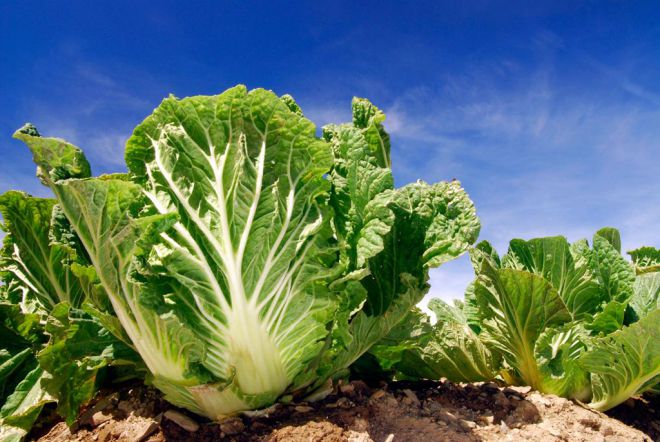 How to grow Chinese cabbage on your site?
How to grow Chinese cabbage on your site?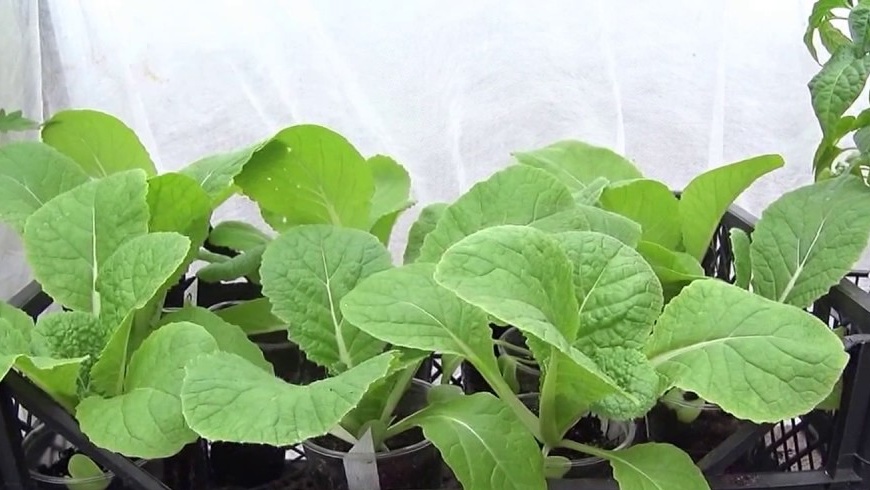 When to plant Chinese cabbage on seedlings in 2024
When to plant Chinese cabbage on seedlings in 2024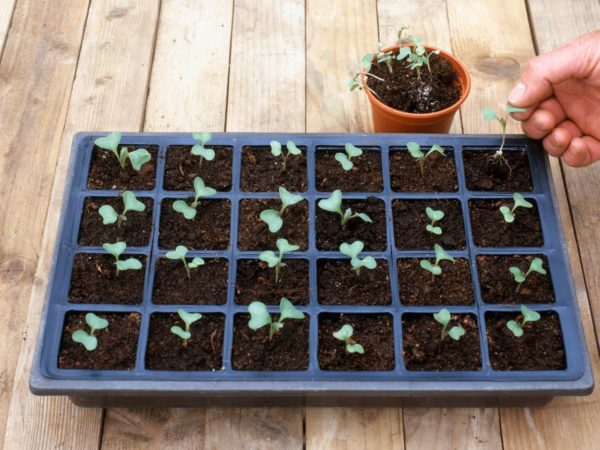 When to sow cabbage for seedlings in 2019 on the moon
When to sow cabbage for seedlings in 2019 on the moon Cauliflower: how to grow large snow-white inflorescences
Cauliflower: how to grow large snow-white inflorescences